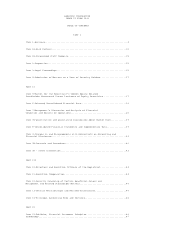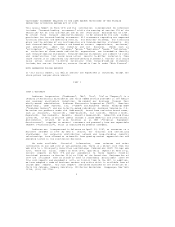Audiovox 2005 Annual Report Download - page 17
Download and view the complete annual report
Please find page 17 of the 2005 Audiovox annual report below. You can navigate through the pages in the report by either clicking on the pages listed below, or by using the keyword search tool below to find specific information within the annual report. We do not manufacture our products, and we do not have long−term contracts
with our suppliers. Most of our products are imported from suppliers under
short−term purchase orders. Accordingly, we can give no assurance that:
o our supplier relationships will continue as presently in effect,
o our suppliers will not become competitors,
o our suppliers will be able to obtain the components necessary to
produce high−quality,technologically−advanced products for us,
o we will be able to obtain adequate alternatives to our supply
sources should they be interrupted,
o if obtained, alternatively sourced products of satisfactory quality
would be delivered on a timely basis, competitively priced, comparably
featured or acceptable to our customers, and
o our suppliers have sufficient financial resources to fulfill their
obligations.
On occasion our suppliers have not been able to produce the quantities of
products that we desire. Our inability to supply sufficient quantities of
products that are in demand could reduce our profitability and have a material
adverse effect on our relationships with our customers. If any of our supplier
relationships were terminated or interrupted, we could experience an immediate
or long−term supply shortage, which could have a material adverse effect on our
business.
THE IMPACT OF FUTURE SELLING PRICES AND TECHNOLOGICAL ADVANCEMENTS MAY CAUSE
PRICE EROSION AND ADVERSELY IMPACT OUR PROFITABILITY AND INVENTORY VALUE
Since we do not make any of our own products and do not conduct our own
research, we cannot assure you that we will be able to source technologically
advanced products in order to remain competitive. Furthermore, the introduction
or expected introduction of new products or technologies may depress sales of
existing products and technologies. This may result in declining prices and
inventory obsolescence. Since we maintain a substantial investment in product
inventory, declining prices and inventory obsolescence could have a material
adverse effect on our business and financial results.
The Company's estimates of excess and obsolete inventory may prove to be
inaccurate, in which case the Company may have understated or overstated the
provision required for excess and obsolete inventory. Although the Company makes
every effort to ensure the accuracy of its forecasts of future product demand,
any significant unanticipated changes in demand or technological developments
could have a significant impact on the value of the Company's inventory and its
reported operating results.
BECAUSE WE PURCHASE A SIGNIFICANT AMOUNT OF OUR PRODUCTS FROM SUPPLIERS IN
PACIFIC RIM COUNTRIES, WE ARE SUBJECT TO THE ECONOMIC RISKS ASSOCIATED WITH
CHANGES IN THE SOCIAL, POLITICAL, REGULATORY AND ECONOMIC CONDITIONS INHERENT IN
THESE COUNTRIES.
We import most of our products from suppliers in the Pacific Rim. Countries
in the Pacific Rim have experienced significant social, political and economic
upheaval over the past several years. Due to the large concentrations of our
purchases in Pacific Rim countries, particularly Japan, China, South Korea, and
Taiwan, any adverse changes in the social, political, regulatory and economic
conditions in these countries may materially increase the cost of the products
that we buy from our foreign suppliers or delay shipments of products, which
could have a material adverse effect on our business. In addition, our
dependence on foreign suppliers forces us to order products further in advance
than we would if our products were manufactured domestically. This increases the
risk that our products will become obsolete or face selling price reductions
before we can sell our inventory.
12
























